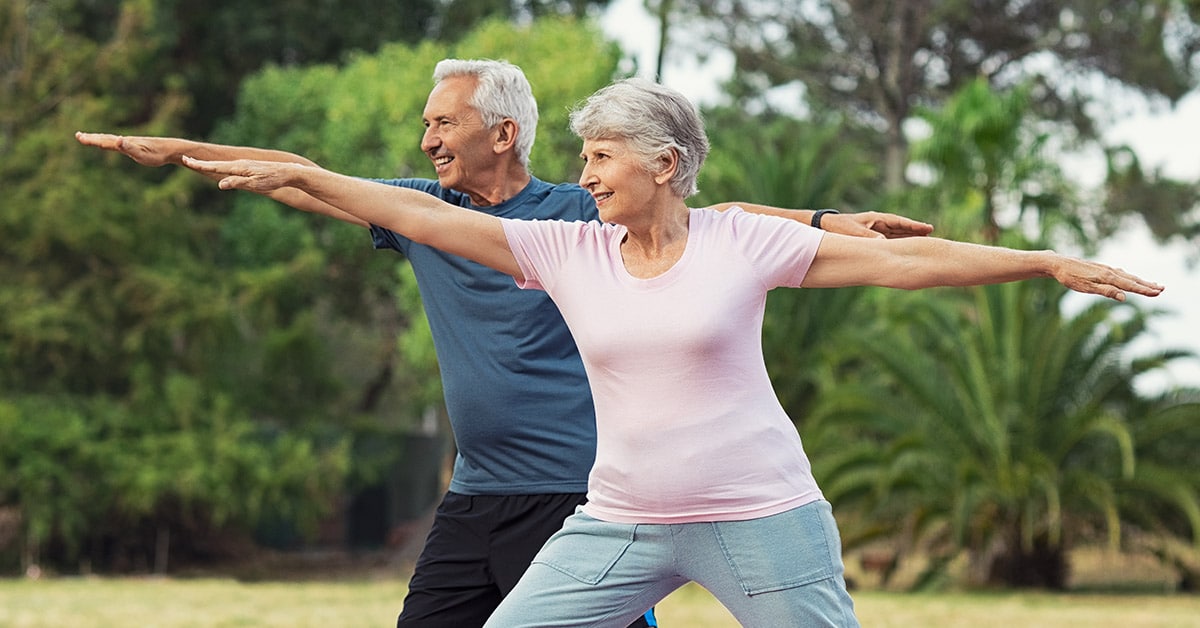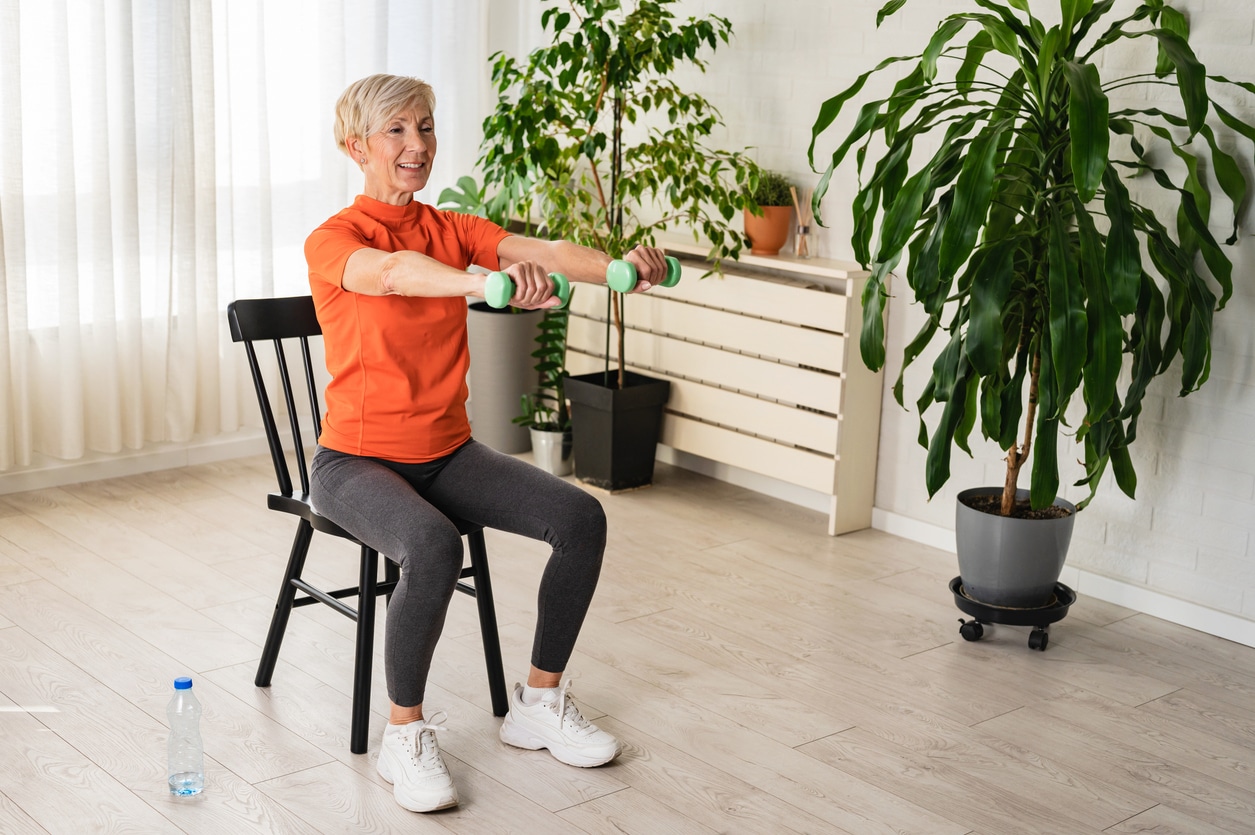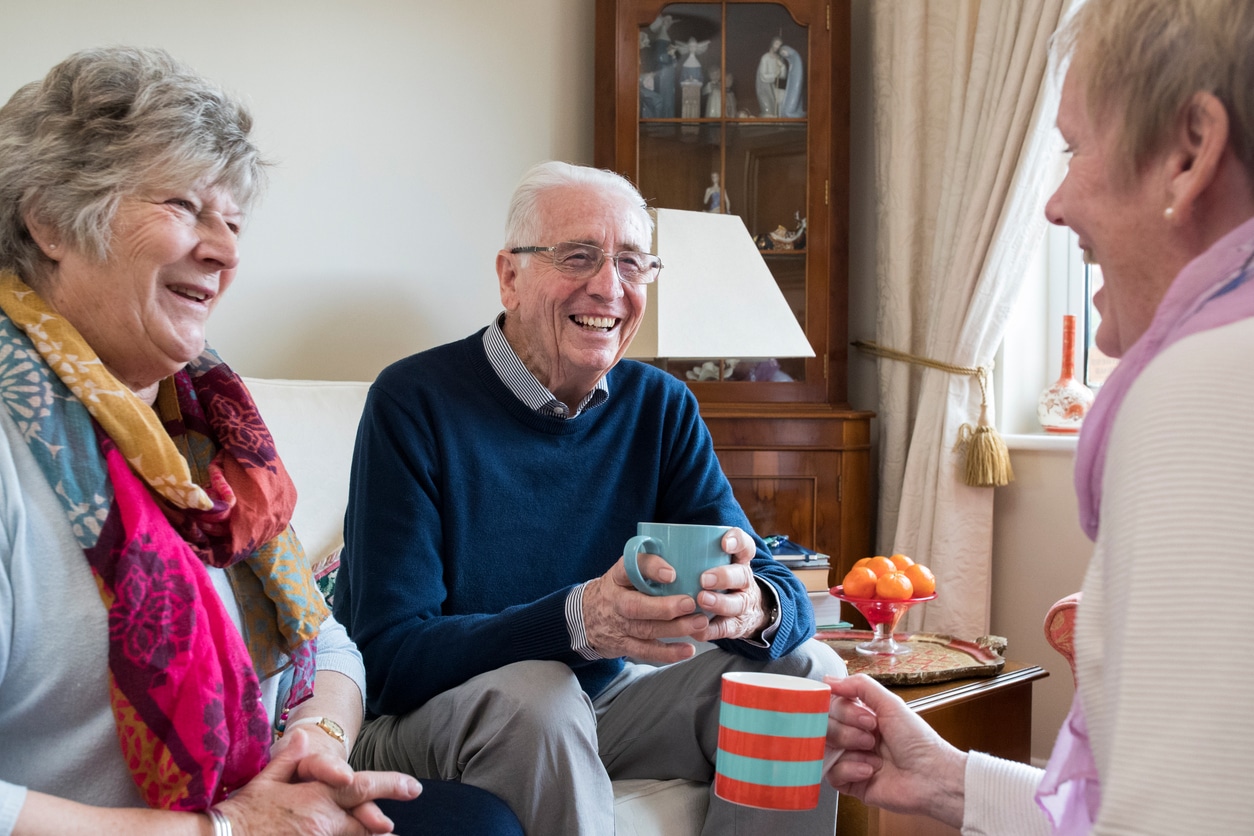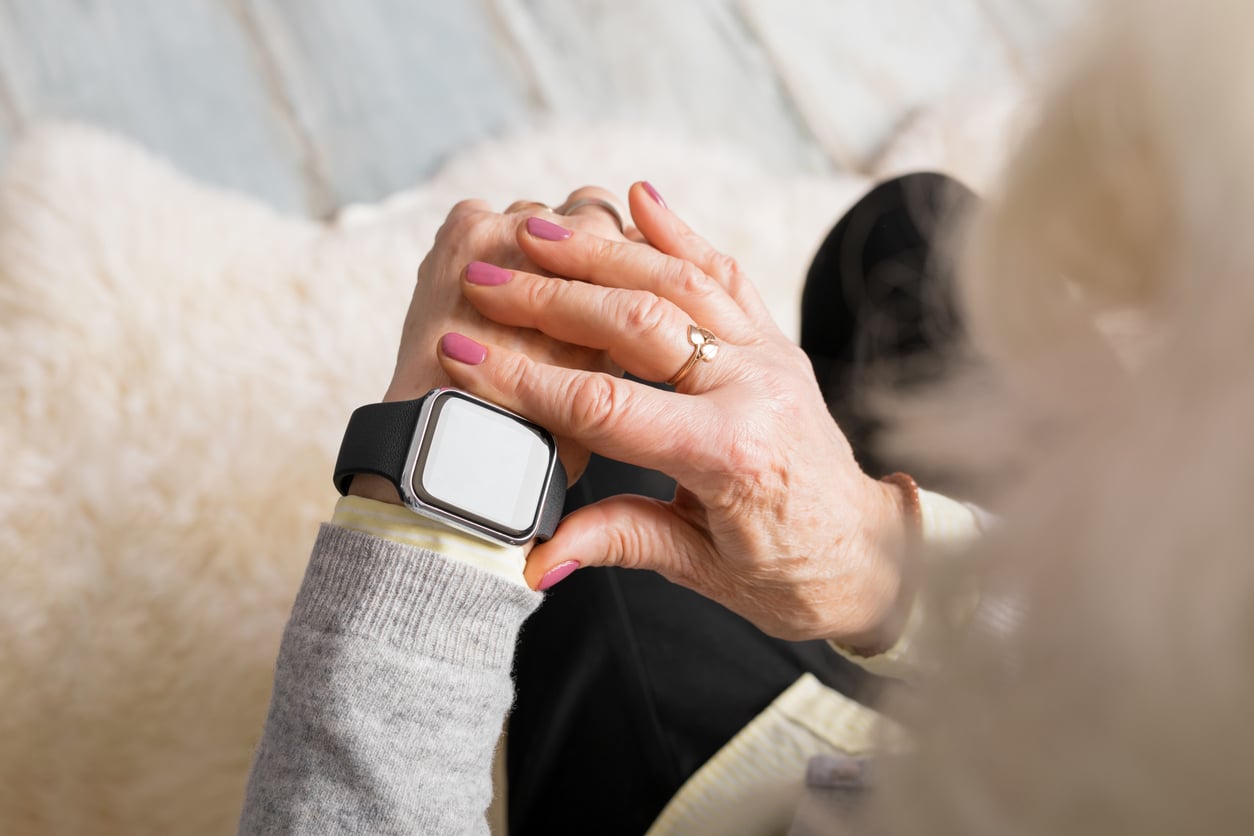Falls are the leading cause of injury-related death for Americans 65 and older, according to data from the CDC.1 Luckily, there are many ways to lower the likelihood of taking a tumble and increase your ability to recover. Two of the most effective are:
- Exercises. One of the main risk factors is poor strength and balance.2 There are lots of exercises for seniors that improve balance, mobility, strength and stability. (See below.)
- A personal medical alert system. The amount of time we’re down after a fall can profoundly affect our ability to return to independent living. A system with fall detection empowers you to get help when you need it before and after a fall – at home and on the go.
We asked Meg Poe, a national board-certified health and wellness coach in Hillsborough, NC, to share beneficial exercises for seniors at home.
Getting Started with Balance, Strength & Flexibility Exercises
Before you attempt any activity, talk to your primary care provider. Then find a place in your home that’s safe and supports your needs.
“You don’t need a home gym, but you do need an area where you can safely move,” Poe says. “Don’t increase the risk of falling by exercising with clutter in your space. Clear any tripping hazards, and, if possible, create a calm space where you can focus on you, your body and your balance.”
See 5 ways to reduce fall risk at home.
Next, think about the support you need.
A doorway is Poe’s favorite at-home space for people needing a little backup. “Typically, there’s no clutter in a doorway. You have support on both sides and there’s nothing limiting your leg movement,” she explains. “The door frame is also a great reference for your alignment and encourages you to stand tall.”
You can also work out beside the kitchen counter or with a chair. But if you choose the latter, Poe says to make sure it’s sturdy with no wheels and is tall enough that it doesn’t cause you to round forward.
When you’re ready to go, remember to:
- Start slow. Begin with 3-8 repetitions per side and work up to 10-12. “If that becomes easy and you’d like to do more, add a second set, starting with fewer repetitions and gradually increasing them,” Poe says.
- Honor your body. Listen to the information your body is giving you. “It’s extra important when asking your body to do new things,” she notes. “Exercise is about making your body healthier and happier, not about creating pain. Yes, you may get a little sore after doing new movements – that happens. But while performing exercises, you should not feel pain. If any movement causes pain stop.”
Balance Exercises for Seniors
Stand Tall
“When our posture is more rounded or curved, it impacts our balance,” Poe explains. “This exercise helps us build the muscles that help us stand up straight and is the foundation for all the exercises in this list.”
Stand with your feet a comfortable distance apart and pressed evenly into the floor, crown of your head high. Keep a slight bend in your knees. “Locking out” your knees (also known as hyperextending) may negatively impact your balance and cause lower back pain. Once you establish your best alignment, close your eyes, and notice how you feel. A little swaying and wobbling are OK, Poe notes, and is why a counter, doorway or chair should be close by. Pro Tip: Try this in front of a mirror to see where you need to adjust. “A good guideline for alignment is crown of the head high, ears over shoulders, shoulders over ribcage, ribcage over pelvis and pelvis over heels,” she says.
Exercises for Balance and Strength
Lower Body Exercises for Balance and Strength
Heel Raises
Stand tall. Slowly lift your heels and roll up on the balls of your feet. Begin with a small lift and gradually lift your heels higher. Hold. Slowly return the heels to the floor. Create more intensity by holding the lift longer time or, if you feel steady, raising your arms in front of you.
Ankle Movements
Stand tall. Shift your weight/center of gravity to the left leg. Lift the heel of the right foot and then the toes so you’re balanced on the other foot. Lift your right knee as high as is comfortable. When you lift the knee, your shoulder and head may want to round forward. Keep the crown of the head high. Point and flex at the right ankle several times. Then rotate the foot in one direction and then the other. Place the right foot on the floor. Repeat on the other side. Pro Tip: Don’t need support? Explore different arm positions. What helps or hinders your balance?
Rock the Boat
Stand tall, feet at least shoulder distance apart (wider than you) and pressed into the ground firmly. Look directly ahead of you at eye level, not down. Shift your weight to your right foot and lift your left heel off the floor so you’re on the toes of the left foot. Pause. Lower the left heel and shift to the other side. Continue shifting side-to-side, varying the speed as you become more comfortable.
Level Up: Rock the Boat with Arm and Leg Movement. As your balance improves, explore different arm positions, such as hands on hips or arms swaying side-to-side. You can also lift your left foot off the floor, pause, lower from side to side. Notice the additional muscles needed for the side leg lift.
Straight Leg Lifts to the Back
Stand tall. Engage your tummy/core and shift your weight/center of gravity to the left leg. Maintain a long right leg. Flex your right foot. Lift your right leg back behind you. Your torso may tilt forward slightly but keep the crown of the head high and do not bend forward. Complete several repetitions on the right leg and then set up for the other side. “This small movement strengthens your glutes, torso and the backs of your legs,” she says.
March in Place
Stand tall. Shift your weight to the left leg and engage your core. With control, lift your right knee with the foot flexed. Your shoulders and head may want to round forward. Keep the crown of the head high. Lift your knee as high as you can without going above hip height and keep your thigh parallel to the floor. Pause with knee lifted. Place the foot on the floor. Shift to the other side. Repeat.
Upper Body Exercises for Balance and Flexibility
Shoulder Rolls
“Our shoulders have a huge range of motion – up, forward, back, and down,” Poe notes. “Most activities of daily living cause our shoulders to round towards the front of our bodies. We tend to over-correct and press our shoulders too far back. This exercise helps address that.”
Stand tall, arms by your sides. Raise your shoulders toward your ears, gently shift them forward, then down and back and up toward the ears again. Complete several circles in this direction and then switch, doing the same number on both sides. Finish with your shoulder away from your ears and slightly back. Pro Tip: Stand in front of a mirror and adjust your alignment as needed.
Side Arm Lifts
Stand tall, arms resting by your sides. Lift arms out to the side to about shoulder level and rotate the arms so the palms face the ceiling. As you return the arms to your sides, rotate the arm so the palms face your thighs. With each lift to the side, reach your arms higher as your shoulder range of motion allows. If comfortable, look up to the ceiling as the hands float high to add movement for your neck. Continue for the number of repetitions comfortable for your shoulders. Pro Tip: “The two sides of our body are different,” Poe explains. “If one arm lifts the fingertips to the ceiling and the other does not, that’s okay. Honor each shoulder’s range of motion.”
Front Arm Lifts
Stand tall, arms resting by your sides. Lift arms in front of you to about shoulder level, palms facing each other. Float arms back to your sides with palms facing your body. With each repetition, allow the arms to raise higher as your shoulders allow. If comfortable, look up to the ceiling as the hands float high to add movement for your neck. Continue for the number of repetitions comfortable for your shoulders.
Discover low-impact exercises that can make you stronger and lower fall risk.
Exercises to Improve Coordination and Balance
The following exercises are advanced and involve multiple moves. “When you combine exercises and perform different movements with the two sides of the body, greater improvement occurs,” Poe explains.
Heel Lifts with Alternating Arm Lifts
Stand tall. Slowly lift your heels and roll up on the balls of your feet. Begin with a small lift and gradually lift your heels higher. Hold. Slowly return the heels to the floor. After several repetitions, combine Heel Lifts and Side Arm Lifts, raising arms to about shoulder level and rotating palms toward the ceiling as you lift the heels. Float arms down to your sides as the heels return to the floor. Complete a few several repetitions, then switch to front arm lifts. Lift heels and raise arms to about shoulder level, palms facing each other. Lower heels and float arms back to your sides with palms facing your body. Complete another few repetitions. Take a break and a breath to set your focus before starting again, alternating lifts this time. As you begin to lift your heels, float one arm to the side and the other to the front. Hold. Lower your heels and your arms. On the next raise, the opposite arm floats to the side and the other in front. Continue for several sets. Pro Tip: “Stay focused and laugh when appropriate,” Poe counsels. “This is big time!”
Heel-Toe Walking
Stand tall. Put your right foot in front of your left so that the right heel touches the front of your left toes. Slowly move your left foot in front of your right, putting your weight on your left heel and rolling forward to the ball of your foot. The closer the placement of heel-to-toe the more challenging the exercise. If you need to step the feet further apart, start there. If you need support, walk alongside a countertop or in a hallway. Pro Tip: “If you’re so caught up in the placement of your feet that you’re looking down and losing alignment, stop focusing on the detailed foot placement and maintain your alignment,” she notes.
Get expert tips for training smart.
Post-Workout Ideas for Seniors
Calf Stretch
Stand arm’s length from a wall, countertop or sturdy chair. Bend your right knee as you extend your left leg behind you into a lunge. Control the intensity by sliding your foot further back and pressing your heel toward the floor. Hold for 15 to 30 seconds, then switch leg positions. Repeat two to four times per leg. Pro Tip: If you feel stable, remove your hands from the support to add an extra balance challenge to the stretch.
Foot Massage
“The health of your feet is key in maintaining balance,” Poe asserts. This easy foot massage keeps your feet flexible. Stand or sit tall. Place a tennis ball or racquetball under your foot (a softball, baseball or golf ball works, too). Gently roll side to side and front to back, enjoying the pressure of the ball on your foot. “If you find a place that feels really good, hang out a while,” she suggests. After a minute or so on one foot, then switch to the other.
Look into how yoga can help you get stronger, be more flexible and lower fall risk.
Prioritizing Wellness as You Age
“Balance, flexibility and strength are key to good health and fitness — and to success in the activities of daily living,” Poe says. “Basic things like looking at someone when you have a conversation, walking across a room or putting on your socks, these things require balance, flexibility and strength.”
So does avoiding slips, trips and falls. And if we do fall, these factors can make it easier to get off the ground or floor, lower the risk of serious injury, and boost our ability to recover quickly. We may even be able to skip a trip to the emergency room.
Know what to do after you fall.
Yet many of us find it hard to make time for the exercise we need.
“I’m not sure what made us all believe an hour-plus at the gym is required,” Poe says. “I know many people discover great benefits from 15 minutes of balance, flexibility and strength exercise a day. And I’m willing to bet that you’ll enjoy the 15 minutes so much you’ll make time for more.” Why? “If we maintain our health,” Poe concludes, “we’re more likely to enjoy our time and live a long full life.”
Review our guide to choosing the right personal emergency alert system for you.
Don’t disregard professional medical advice, or delay seeking it, because of what you read here. This information is not intended as a substitute for professional consultation, diagnosis or treatment; it is provided “as is” without any representations or warranties, express or implied. Always consult a healthcare provider if you have specific questions about any medical matter, and seek professional attention immediately if you think you or someone in your care may be experiencing a healthcare condition or medical emergency.
1Centers for Disease Control and Prevention, National Center for Injury Prevention and Control. Web-based Injury Statistics Query and Reporting System (WISQARS) [online].
2 CDC – National Center for Injury Prevention and Control – Deaths from Older Adult Falls. https://www.cdc.gov/falls/data/fall-deaths.html. January 3, 2021.




